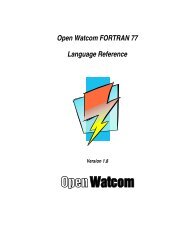Relocatable Object Module Format (OMF) Specification
Relocatable Object Module Format (OMF) Specification
Relocatable Object Module Format (OMF) Specification
Create successful ePaper yourself
Turn your PDF publications into a flip-book with our unique Google optimized e-Paper software.
<strong>Relocatable</strong> <strong>Object</strong> <strong>Module</strong> <strong>Format</strong><br />
This field must contain one of the three values given above, but the specific value is ignored by most linkers.<br />
The Length in Bits field is a variable-length field that indicates the size of the communal variable. Its format<br />
depends on the size it represents.<br />
If the first byte of the size is 128 (80H) or less, then the size is that value. If the first byte of the size is 81H, then a<br />
2-byte size follows. If the first byte of the size is 84H, then a 3-byte size follows. If the first byte of the size is 88H,<br />
then a 4-byte size follows.<br />
If the Leaf Descriptor field describes a FAR variable (one that must be referenced with an explicit segment and<br />
offset), the format is:<br />
1 1 <br />
61H Variable Number of Elements Element Type Index<br />
Type (77H)<br />
The 1-byte field containing 61H signifies a FAR variable.<br />
The 1-byte variable type for a FAR communal variable is restricted to 77H (array). (As with the NEAR Variable<br />
Type field, the linker ignores this field, but it must have the value 77H.)<br />
The Number of Elements field is a variable-length field that contains the number of elements in the array. It has<br />
the same format as the Length in Bits field in the Leaf Descriptor field for a NEAR variable.<br />
The Element Type Index field is an index field that references a previous TYPDEF record. A value of 1 indicates<br />
the first TYPDEF record in the object module, a value of 2 indicates the second TYPDEF record, and so on. The<br />
TYPDEF record referenced must describe a NEAR variable. This way, the data type and size of the elements in<br />
the array can be determined.<br />
Note: Microsoft LINK limits the number of TYPDEF records in an object module to 256.<br />
Examples<br />
The following three examples of TYPDEF records were generated by Microsoft C Compiler version 3.0. (Later<br />
versions use COMDEF records.)<br />
The first sample TYPDEF record corresponds to the public declaration:<br />
int var; /* 16-bit integer */<br />
The TYPDEF record is:<br />
0 1 2 3 4 5 6 7 8 9 A B C D E F<br />
0000 8E 06 00 00 00 62 7B 10 7F .....b{..<br />
Byte 00H contains 8EH, indicating that this is a TYPDEF record.<br />
Bytes 01-02H contain 0006H, the length of the remainder of the record.<br />
Byte 03H (the name field) contains 00H, a null name.<br />
Tool Interface Standards (TIS) <strong>OMF</strong> <strong>Specification</strong>, Version 1.1 79
















